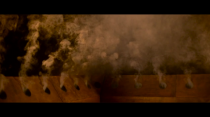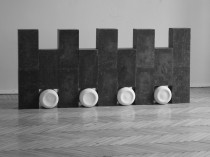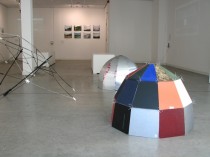I have just been asked to write a foreword for a catalogue for Stage 3 Sculpture at Grays School of Art. The booklet charts a project the students undertook to investigate Hidden or Forgotten Spaces throughout Aberdeen, with the current Union Terrace Gardens debate as an inspiration. This is the full version of the text (Which has been edited slightly for publication.)
The notion of place is one of the universal concerns intrinsic to the development of our species since long before we crawled out of the oceans and grew legs. Our immediate and extended context has dictated how society has developed, we have always reacted to the space around us: celebrated it, took inspiration from it, amended it, created new spaces or simply destroyed it.
For an artist, the contemporary concerns about space are often as important to a practice than the materials used or sometimes the final artistic output. While pre-Duchamp, the interest in place was mostly representational – afterwards the focus shifted from representation to an overriding analysis of context that the conceptual concerns with our surroundings came to the fore.
At the dawn of a new century, we seem on the brink of a critical point in perspective and thinking. Two hundred years of industrialisation have irreparably changed the face of the world we live in and it is our generation that has to confront the consequences of this “progress.” Within contemporary practice, the approaches to making, creating and concept often involve working in the public realm, whether large scale site-specific commissions or more subtle interventions or subversive, in-your-face street art, the artist is no longer confined to the studio and artwork no longer to the gallery.
Widespread industrialisation and population migration from rural to urban spaces caused the rapid, unplanned, transformation of cities. Tenements, factories, mills, foundries, stores and roads emerged as societal perspective and priorities changed and our surroundings became less important. The human race had abandoned its former fascination with synergy and natural order with the emergence of the hedonistic pursuit of Capitalism.
In the inevitable decline of heavy industry, forgotten spaces became ubiquitous in the urban landscape, monuments to short sightedness of our forefathers and reminders of the effect of progress on our planet. The transitional period we find ourselves is an area of certain fascination for artists. Gormley’s Angel of The North, built through the processes and materials common to Newcastle’s manufacturing heritage, looks over the city symbolising the cultural awakening of the city; Rachel Whiteread’s House represented the living space of a street which no longer stood, erased from reality and from our memories.
Tracing Place seeks to highlight those forgotten spaces throughout Aberdeen. Simple interventions, such as Amy Flint’s outline footprints, encouraging the viewer to see the cityscape as artwork, or Hannah Malone’s Castlegate, a series of sandcastles crumble across Aberdeen’s Civic Square emphasising the fragility of the space around it: an underutilised, yet historically significant part of the city.
Aberdeen differs greatly from the post-industrial centres discussed. As heavy industry declined across the UK, North Sea Oil gave Aberdeen its own Industrial Revolution. A great many unique features were swept away: historic buildings on Broad Street replaced by St Nicholas House; Old Torry by an oil refinery; the Wallace tower, making way for Mark’s and Spencer.
Even today, with a global shift in priority, Aberdeen, still in the grips of the billion-dollar oil boom, seems destined not to take heed. A project for culture-led rejuvenation of Union Terrace Gardens, a gift to the people of the City, is under threat from a boorish scheme reeking of sixties modernism brought forward by those who have personally benefited from industrial exploitation would see these Gardens ripped out, covered over and wiped from existence.
Projects such as Tracing Place are vital at this particular juncture. The role of the artist is to celebrate our context, remind us of what we have and what we have lost. We must be able to stand back and embrace the beauty around us or we will be forever destined to repeat the mistakes of our past at the expense of our future.
/////
Hidden Spaces – a month of blogs by members about their hidden space – whether they be real, imagined, unbuilt, cut-off from the public, demolished, spiritually significant or politically sublimated. Read more from the series.














Comments